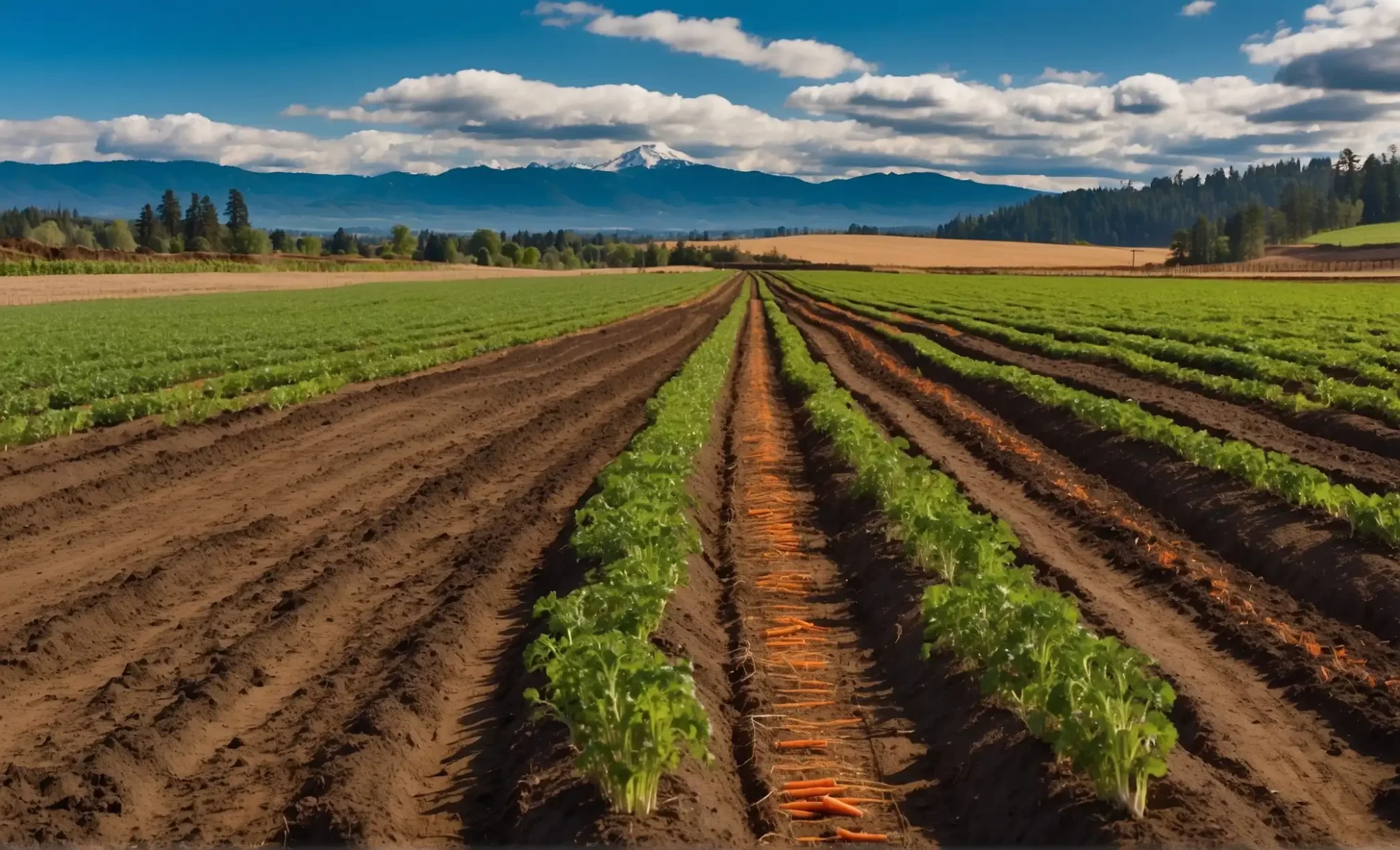In Oregon, the best time to plant carrots is from mid-March to early August for a successful harvest.
Carrot cultivation in Oregon can be a rewarding endeavor for gardeners looking for a crisp, nutritious addition to their homegrown produce. As root vegetables, carrots favor the cooler temperatures found in early spring and late summer which align with Oregon’s climate zones.
Gardeners should consider the state’s diverse weather patterns, with coastal regions experiencing more moisture and eastern areas being drier. These planting windows enable carrots to develop fully before the onset of the state’s cold winters. It’s essential for growers to monitor soil temperature and provide adequate moisture for optimal growth. Success with carrots in Oregon hinges on understanding the local climate and soil conditions, ensuring a bountiful harvest.
Understanding Oregon’s Climate and Soil Conditions for Carrot Cultivation
Planting carrots in Oregon isn’t as simple as putting seeds in the ground. Gardeners must be acutely aware of the intricacies of the region’s climate and soil composition to shepherd their crops from seedlings to harvest. Oregon’s varied landscape results in diverse weather patterns and soil types, both of which are critical to consider for the successful cultivation of carrots. Below, delve into the key factors that Oregonians should consider to optimize their carrot-growing efforts.
Regional Weather Patterns and Their Impact on Gardening
Oregon’s climate varies greatly from the coast to the high desert, with each area presenting unique challenges to gardeners. The coastal region, with its milder temperatures and higher humidity, can lead to longer growing seasons.
In contrast, the higher elevations and the eastern part of the state experience greater temperature fluctuations and drier conditions, which may require different planting strategies such as mulching to retain soil moisture. The Willamette Valley, a prime agricultural area, offers a balanced environment with a good mixture of rain and sun, creating an ideal setting for planting carrots, typically from early spring through late summer.
Soil Texture and Fertility Requirements for Carrot Growth
Carrots thrive in well-drained, sandy loam soils that are free of stones and heavy clays. Soil that is too heavy can cause carrots to grow deformed or stunted. On the other hand, soil that is too loose may not provide enough nutrients. Gardeners should aim for a pH balance between 6.0 and 7.0, which can be achieved by applying well-rotted organic matter that also helps to improve soil structure and fertility. Regular soil tests are recommended to ensure the soil maintains adequate levels of phosphorus and potassium, which are crucial for healthy carrot development.
Identifying Usda Hardiness Zones in Oregon
Understanding the USDA Hardiness Zones is essential for determining the best planting times for carrots in Oregon. The state spans Zones 4 through 9, with the coastal areas generally being warmer (Zone 8-9) and the mountain regions cooler (Zone 4-6). Gardeners should refer to the USDA Hardiness Zone Map to identify their specific zone. For example, in Zone 8, carrots can often be planted in both the spring and fall, while in Zone 6, the planting window may be narrower, focusing on the start of spring or the end of summer. By matching planting schedules to their zone’s temperature patterns, Oregonians can increase their chances of a bountiful carrot harvest.
| USDA Zone | Early Spring Planting | Late Summer Planting |
|---|---|---|
| Zone 4-6 | As soil is workable | Mid to Late Summer |
| Zone 7 | Late March to April | Early to Mid-August |
| Zone 8-9 | February to March | August to September |
The Ideal Plant Carrots in Oregon
Gardening in the Pacific Northwest requires an understanding of the unique climate variations throughout the region. Carrots are a popular crop due to their hardiness and the flavor enhancement that comes from maturing in cool weather. To maximize your carrot harvest in Oregon, careful timing is essential. This guide provides recommendations for when to plant carrots based on Oregon’s diverse growing zones.

Determining the Best Time Frames for Planting Based on Zone
Understanding the specifics of your local climate zone is key to a successful carrot crop. Oregon spans several USDA hardiness zones, which influence the ideal planting dates:
- Coastal Areas (Zone 8) – Sow carrots as early as February, taking advantage of the mild winters.
- Willamette Valley (Zone 8) – Begin planting in March, and continue through early summer.
- Central and Eastern Oregon (Zones 5-7) – Wait until late April or May when the soil has thoroughly warmed.
Track your specific zone’s average last frost date for the most accurate planting time.
The Significance of Frost Dates in Scheduling Planting
The risk of frost is a significant factor in setting your planting schedule. Carrots can endure a light frost, but the key is to plant them early enough that they have time to mature before the first fall frost. Here’s a general guideline:
- Determine your area’s average last spring frost date.
- Carrots need around 70 to 80 days to mature. Plant seeds 2-3 weeks before the last frost date to get a head-start on the growing season.
- Monitor local weather forecasts to safeguard young shoots from unexpected late frosts.
Ensure soil preparation includes loosening the soil and incorporating organic matter for proper drainage and nutrient availability, critical in colder climates.
Successional Planting: Strategies for Extended Harvests
To enjoy fresh carrots throughout the growing season, employ a technique called successional planting:
- Stagger planting times by sowing seeds every 3 to 4 weeks.
- Continue until mid-summer; this often means planting until late July or early August.
- Note the date of expected fall frost and count back from it to determine the last viable planting date.
By planting smaller amounts of carrots over an extended period, you extend the harvest time and reduce the risk of glut and waste.
Read more: How Many Carrots Do I Need to Eat to Improve My Eyesight
Preparing Your Garden for Carrot Planting
Whether you’re a beginner gardener or a green thumb, preparing your garden for carrot planting sets the foundation for a successful harvest. In Oregon’s unique climate, timing and soil conditions are critical to carrot growth. Mastering these key steps can elevate your gardening game and bring you crisp, sweet carrots right from your backyard.
Soil Preparation: Tilling and Amendment Techniques
Carrots thrive in soft, well-drained soil rich in organic matter. Before sowing any seeds, proper soil preparation is a crucial step that shouldn’t be overlooked. Begin by:
- Tilling the garden bed to a depth of at least 12 inches to loosen the soil and eliminate any debris or rocks that may obstruct root growth.
- Incorporating organic amendments like compost or aged manure to enrich the soil with nutrients. A well-balanced soil promotes healthy, straight carrots.
- Ensuring the soil’s pH is between 6.0 and 6.8, which is the ideal range for carrots. You may need to adjust with lime or sulfur based on a soil test result.
Remember, meticulous soil prep leads to less resistance for carrot roots, allowing them to develop to their full potential.
Choosing the Right Carrot Varieties for Oregon
Not all carrot varieties are created equal, especially in Oregon. You’ll want to select types well-suited to the Pacific Northwest climate. Consider these pointers:
- Opt for shorter varieties like ‘Oxheart’ or ‘Parisian’ if your soil is heavy or clayey.
- Longer varieties, such as ‘Imperator’ or ‘Nantes’, are perfect for deep, sandy soils common in certain Oregon regions.
- Research and choose varieties that have proven resistant to pests and diseases in Oregon’s unique growing conditions.
Picking the right carrot variety ensures that your garden’s specific conditions are met, resulting in a bountiful harvest.
Creating Optimal Planting Beds: Spacing and Depth Guidelines
Even with the best soil and ideal varieties, carrots need the proper space and depth to develop. When setting up your planting beds, adhere to these guidelines:
| Planting Aspect | Recommendation |
|---|---|
| Sowing Depth | Plant seeds ¼ inch deep, ensuring they have adequate cover to germinate successfully. |
| Row Spacing | Space rows about 12 to 24 inches apart to give ample room for growth and airflow. |
| Seed Spacing | Initially, seeds can be sown thicker and then thinned to 2 to 3 inches apart post-germination. |
Strategic bed setup contributes to optimum carrot development by reducing competition for nutrients and preventing crowding that can lead to misshapen roots.
Know more: How to Grow Carrots in Texas
Care and Maintenance for Thriving Carrot Crops
Successful carrot cultivation in Oregon requires a gardener’s attention and diligence. Carrots are a versatile and nutritious root vegetable, but they need proper care and maintenance to ensure a bountiful harvest. In this section, we’ll delve into some key practices that are crucial for nurturing your carrot crops from seedlings to mature, harvestable roots. Whether you’re an experienced gardener or new to the game, these tips will help your carrots reach their full potential.
Irrigation Practices for Consistent Soil Moisture
Carrots prefer even and consistent soil moisture to develop properly. Too much water can lead to root rot, while too little can cause irregular growth and a woody texture. Follow these irrigation tips:
- Water your carrots with a drip irrigation system or a soaker hose to keep moisture levels even.
- Aim for 1 inch of water per week, either from rainfall or manual watering.
- Use mulch around the plants to help retain soil moisture and regulate temperature.
Weeding and Thinning: Ensuring Healthy Carrot Development
Weeding and thinning are essential for carrots to thrive. Dense growth can hinder proper root development. Maintain your crop with these practices:
- Once seedlings are 2 inches tall, thin them so that they are 1 to 4 inches apart.
- Remove weeds regularly to prevent competition for nutrients and water.
- Thin carefully to avoid disturbing the roots of remaining plants.
Recognizing and Managing Common Pests and Diseases
Several pests and diseases can affect carrot crops. Vigilance is key to early detection and management. Watch for these common issues:
| Pest/Disease | Identification | Control Methods |
|---|---|---|
| Carrot Rust Fly | Larvae that burrow into roots, causing damage | Use row covers; plant resistant varieties |
| Leaf Blight | Fungus causing yellow spots on leaves | Apply fungicides; rotate crops annually |
| Root-knot Nematodes | Microscopic worms causing root galls | Plant marigolds as a cover crop; solarize soil |
By religiously following these care and maintenance guidelines for your carrot crops, a bountiful and healthy harvest can be truly within reach. Remember, carrots are a bit of a commitment, but the reward of crisp, home-grown roots is well worth the effort.
Conclusion
Embarking on your carrot-planting journey in Oregon demands timing as precise as the state’s striking landscapes. Aim for early spring or late summer, aligning with Oregon’s climate patterns for optimal growth. Embrace the season’s cues, and you’ll soon enjoy a bounty of fresh, crunchy carrots straight from your own slice of the Pacific Northwest.
Let your love for carrots grow wild with Farm Pioneer. Our Carrots section is the ideal spot for discovering new and exciting gardening techniques. Happy gardening!
